Sustainability Analysis of Fish Feed Derived from Aquatic Plant and Insect
Abstract
:1. Introduction
2. Materials and Methods
2.1. Experimental Set-Up
2.2. Life Cycle Inventory
2.3. Impact Assessment
3. Results and Discussion
3.1. BSFL Production Results
3.2. LM Production Results
3.3. Result of Pellets (Derived from LM and BSFL) as Feed and Its Comparison to Conventional Feed
4. Conclusions and Outlook
Supplementary Materials
Author Contributions
Funding
Institutional Review Board Statement
Informed Consent Statement
Data Availability Statement
Conflicts of Interest
References
- Cai, J.; Zhou, X. FAO Aquaculture Newsletter; Food and Agriculture Organization of the United Nations: Rome, Italy, 2019. [Google Scholar]
- Food and Agriculture Organization of the United Nations. Aquaculture. Available online: http://www.fao.org/fishery/aquaculture/en (accessed on 22 March 2021).
- Edwards, O.; Bicknell, B.; Ford, J.; Yiu, B.; Blecher, M.; Mulvaney, W. Aquaculture Methods. Good Fish Bad Fish. Available online: http://goodfishbadfish.com.au/?page_id=33 (accessed on 8 June 2021).
- Aubin, J.; Papatryphon, E.; Werf, H.M.; Chatzifotis, S. Assessment of the environmental impact of carnivorous finfish production systems using life cycle assessment. J. Clean. Prod. 2009, 17, 354–361. [Google Scholar] [CrossRef]
- Ayer, N.; Tyedmers, P.H. Assessing alternative aquaculture technologies: Life cycle assessment of salmonid culture systems in Canada. J. Clean. Prod. 2009, 17, 362–373. [Google Scholar] [CrossRef]
- Iribarren, D.; Moreira, M.T.; Feijoo, G. Revisiting the Life Cycle Assessment of mussels from a sectorial perspective. J. Clean. Prod. 2010, 18, 101–111. [Google Scholar] [CrossRef]
- ISO. ISO 14040:2006—Environmental Management—Life Cycle Assessment—Principles and Framework; International Organization for Standardization: Geneva, Switzerland, 2006. [Google Scholar]
- ISO. ISO 14044:2006–Environmental Management—Life Cycle Assessment—Requirements and Guidelines; International Organization for Standardization: Geneva, Switzerland, 2006. [Google Scholar]
- Iles, A. Making the seafood industry more sustainable: Creating production chain transparency and accountability. J. Clean. Prod. 2007, 15, 577–589. [Google Scholar] [CrossRef]
- Ayer, N.; Côté, R.P.; Tyedmers, P.H.; Willison, J.M. Sustainability of seafood production and consumption: An introduction to the special issue. J. Clean. Prod. 2009, 17, 321–324. [Google Scholar] [CrossRef]
- Belghit, I.; Liland, N.S.; Gjesdal, P.; Biancarosa, I.; Menchetti, E.; Li, Y.; Waagbo, R.; Krogdahl, Å.; Lock, E.-J. Black soldier fly larvae meal can replace fish meal in diets of sea-water phase Atlantic salmon (Salmo salar). Aquaculture 2019, 503, 609–619. [Google Scholar] [CrossRef]
- Stadtlander, T.; Stamer, A.; Buser, A.; Wohlfahrt, J.; Leiber, F.; Sandrock, C. Hermetia illucens meal as fish meal replacement for rainbow trout on farm. J. Insects Food Feed. 2017, 3, 165–175. [Google Scholar] [CrossRef] [Green Version]
- Chakrabarti, R.; Clark, W.D.; Sharma, J.G.; Goswami, R.K.; Shrivastav, A.K.; Tocher, D. Mass Production of Lemna minor and Its Amino Acid and Fatty Acid Profiles. Front. Chem. 2018, 6, 479. [Google Scholar] [CrossRef]
- Sharma, J.G.; Kumar, A.; Saini, D.; Targay, N.L.; Khangembam, B.K.; Chakrabarti, R. In vitro digestibility study of some plant protein sources as aquafeed for carps Labeo rohita and Cyprinus carpio using pH-Stat method. Indian J. Exp. Biol. 2016, 54, 606–611. [Google Scholar] [PubMed]
- Leng, R.A.; Stambolie, J.H.; Bell, R. Duckweed—A potential high-protein feed resource for domestic animals and fish. Livest. Res. Rural Dev. 1995, 7, 36. [Google Scholar]
- Muhlberg, H. The Complete Guide to Water Plants; E. P. Publishing Ltd.: Leipzig, Germany, 1982. [Google Scholar]
- Huxley, A. The New Royal Horticultural Society Dictionary of Gardening; MacMillan Press: New York, NY, USA, 1992. [Google Scholar]
- Kuppusamy, G.; Kong, C.K.; Segaran, G.C.; Tarmalingam, E.; Herriman, M.; Ismail, M.F.; Khan, T.M.; Low, L.E.; Goh, B.-H. Hummingbird-Leaves-Reared Black Soldier Fly Prepupae: Assessment of Nutritional and Heavy Metal Compositions. Biology 2020, 9, 274. [Google Scholar] [CrossRef] [PubMed]
- Rumpold, B.A.; Schlüter, O.K. Potential and challenges of insects as an innovative source for food and feed production. Innov. Food Sci. Emerg. Technol. 2013, 17, 1–11. [Google Scholar] [CrossRef]
- TROVET. Hypoallergenic (Insect)|IPD. (TROVET). Available online: https://www.trovet.com/product/hypoallergenic-insect-dog/ (accessed on 20 April 2021).
- Lei, X.; Kim, T.; Park, J.; Kim, I. Evaluation of Supplementation of Defatted Black Soldier Fly (Hermetia illucens) Larvae Meal in Beagle Dogs. Ann. Anim. Sci. 2019, 19, 767–777. [Google Scholar] [CrossRef] [Green Version]
- European Commission. (25. May 2017). EUR-Lex Access to European Union Law. Available online: https://eur-lex.europa.eu/legal-content/EN/TXT/PDF/?uri=CELEX:32017R0893&from=EN (accessed on 20 April 2021).
- Lozano, S.; Iribarren, D.; Moreira, M.T.; Feijoo, G. The link between operational efficiency and environmental impacts: A joint application of Life Cycle Assessment and Data Envelopment Analysis. Sci. Total Environ. 2009, 407, 1744–1754. [Google Scholar] [CrossRef]
- Lozano, S.; Iribarren, D.; Moreira, M.T.; Feijoo, G. Environmental impact efficiency in mussel cultivation. Resour. Conserv. Recycl. 2010, 54, 1269–1277. [Google Scholar] [CrossRef]
- Iribarren, D.; Moreira, M.T.; Feijoo, G. Life Cycle Assessment of mussel culture. In Mussels: Anatomy, Habitat and Environmental Impact (S. 357–378); McGevin, L.E., Ed.; Nova Science Publishers: New York, NY, USA, 2011. [Google Scholar]
- European Commission. Commission Regulation (EU) 2017/893 of 24 May 2017 Amending Annexes I and IV to Regulation (EC) No 999/2001 of the European Parliament and of the Council and Annexes X, XIV and XV to Commission Regulation (EU) No 142/2011 on processed animal protein. Off. J. Eur. Union. Available online: https://op.europa.eu/en/publication-detail/-/publication/d07e2398-410c-11e7-a9b0-01aa75ed71a1 (accessed on 20 April 2021).
- Smetana, S.; Palanisamy, M.; Mathys, A.; Heinz, V. Sustainability of insect use for feed and food: Life Cycle Assessment perspective. J. Clean. Prod. 2016, 137, 741–751. [Google Scholar] [CrossRef]
- Fusi, A.; Bacenetti, J.; Fiala, M.; Azapagic, A. Life Cycle Environmental Impacts of Electricity from Biogas Produced by Anaerobic Digestion. Front. Bioeng. Biotechnol. 2016, 4, 1–17. [Google Scholar] [CrossRef] [PubMed] [Green Version]
- Roffeis, M.; Almeida, J.; Wakefield, M.E.; Valada, T.R.A.; Devic, E.; Koné, N.; Kenis, M.; Nacambo, S.; Fitches, E.C.; Koko, G.K.D.; et al. Life Cycle Inventory Analysis of Prospective Insect Based Feed Production in West Africa. Sustainability 2017, 9, 1697. [Google Scholar] [CrossRef] [Green Version]
- Oonincx, D.G.; Boer, I.J. Environmental Impact of the Production of Mealworms as a Protein Source for Humans—A Life Cycle Assessment. PLoS ONE 2012, 7, e51145. [Google Scholar] [CrossRef] [Green Version]
- Huis, A.V.; Itterbeeck, J.V.; Klunder, H.; Mertens, E.; Halloran, A.; Muir, G.; Vantomme, P. Edible Insects: Future Prospects for Food and Feed Security; Food and Agriculture Organization of the United Nations: Rome, Italy, 2013. [Google Scholar]
- Thévenot, A.; Rivera, J.L.; Wilfart, A.; Maillard, F.; Hassouna, M.; Senga-Kiesse, T.; Le Féon, S.; Aubin, J. Mealworm meal for animal feed: Environmental assessment and sensitivity analysis to guide future prospects. J. Clean. Prod. 2018, 170, 1260–1267. [Google Scholar] [CrossRef]
- Salomone, R.; Saija, G.; Mondello, G.; Giannetto, A.; Fasulo, S.; Savastano, D. Environmental impact of food waste bioconversion by insects: Application of Life Cycle Assessment to process using Hermetia illucens. J. Clean. Prod. 2017, 140, 890–905. [Google Scholar] [CrossRef]
- Rebello, R.Z.; Lima, M.T.W.D.C.; Yamane, L.H.; Siman, R. Characterization of end-of-life LED lamps for the recovery of precious metals and rare earth elements. Resour. Conserv. Recycl. 2020, 153, 104557. [Google Scholar] [CrossRef]
- Wernet, G.; Bauer, C.; Steubing, B.; Reinhard, J.; Moreno-Ruiz, E.; Weidema, B. The ecoinvent database version 3 (part I): Overview and methodology. Int. J. Life Cycle Assess. 2016, 21, 1218–1230. [Google Scholar] [CrossRef]
- Ruiz-Salmón, I.; Laso, J.; Margallo, M.; Villanueva-Rey, P.; Rodríguez, E.; Quinteiro, P.; Dias, A.C.; Almeida, C.; Nunes, M.L.; Marques, A.; et al. Life cycle assessment of fish and seafood processed products – A review of methodologies and new challenges. Sci. Total Environ. 2021, 761, 144094. [Google Scholar] [CrossRef] [PubMed]
- Samuel-Fitwi, B.; Meyer, S.; Reckmann, K.; Schroeder, J.P.; Schulz, C. Aspiring for environmentally conscious aquafeed: Comparative LCA of aquafeed manufacturing using different protein sources. J. Clean. Prod. 2013, 52, 225–233. [Google Scholar] [CrossRef]
- Smárason, B.Ö.; Ögmundarson, Ó.; Árnason, J.; Bjornsdottir, R.; Davíðsdóttir, B. Life Cycle Assessment of Icelandic Arctic Char Fed Three Different Feed Types. Turk. J. Fish. Aquat. Sci. 2017, 17, 79–90. [Google Scholar] [CrossRef]
- Mohedano, R.A.; Costa, R.H.; Tavares, F.A.; Filho, P.B. High nutrient removal rate from swine wastes and protein biomass production by full-scale duckweed ponds. Bioresour. Technol. 2012, 112, 98–104. [Google Scholar] [CrossRef] [Green Version]
- Bonanno, G.; Vymazal, J.; Cirelli, G.L. Translocation, accumulation and bioindication of trace elements in wetland plants. Sci. Total. Environ. 2018, 631-632, 252–261. [Google Scholar] [CrossRef]
- Olette, R.; Couderchet, M.; Biagianti, S.; Eullaffroy, P. Toxicity and removal of pesticides by selected aquatic plants. Chemosphere 2008, 70, 1414–1421. [Google Scholar] [CrossRef]
- Matamoros, V.; Nguyen, L.X.; A Arias, C.; Salvado, V.; Brix, H. Evaluation of aquatic plants for removing polar microcontaminants: A microcosm experiment. Chemosphere 2012, 88, 1257–1264. [Google Scholar] [CrossRef]
- Ergen, Ş.F.; Tunca, E. Üçüncü Nanotoxicity modelling and removal efficiencies of ZnONP. Int. J. Phytoremediation 2018, 20, 16–26. [Google Scholar] [CrossRef] [PubMed]
- Ekperusi, A.O.; Sikoki, F.D.; Nwachukwu, E.O. Application of common duckweed (Lemna minor) in phytoremediation of chemicals in the environment: State and future perspective. Chemosphere 2019, 223, 285–309. [Google Scholar] [CrossRef] [PubMed]
- Schmitt, E.; de Vries, W. Potential benefits of using Hermetia illucens frass as a soil amendment on food production and for environmental impact reduction. Curr. Opin. Green Sustain. Chem. 2020, 25, 100335. [Google Scholar] [CrossRef]
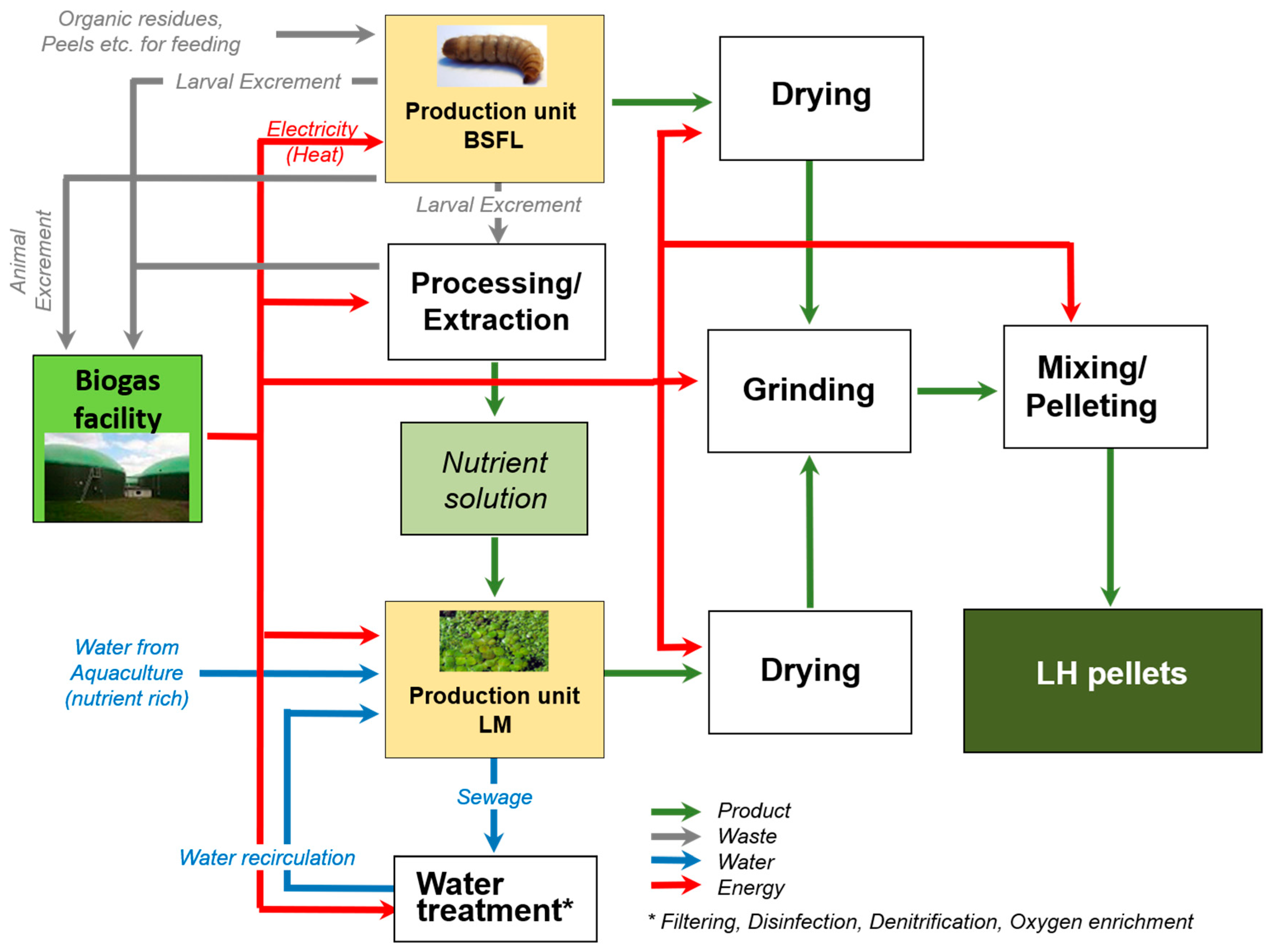
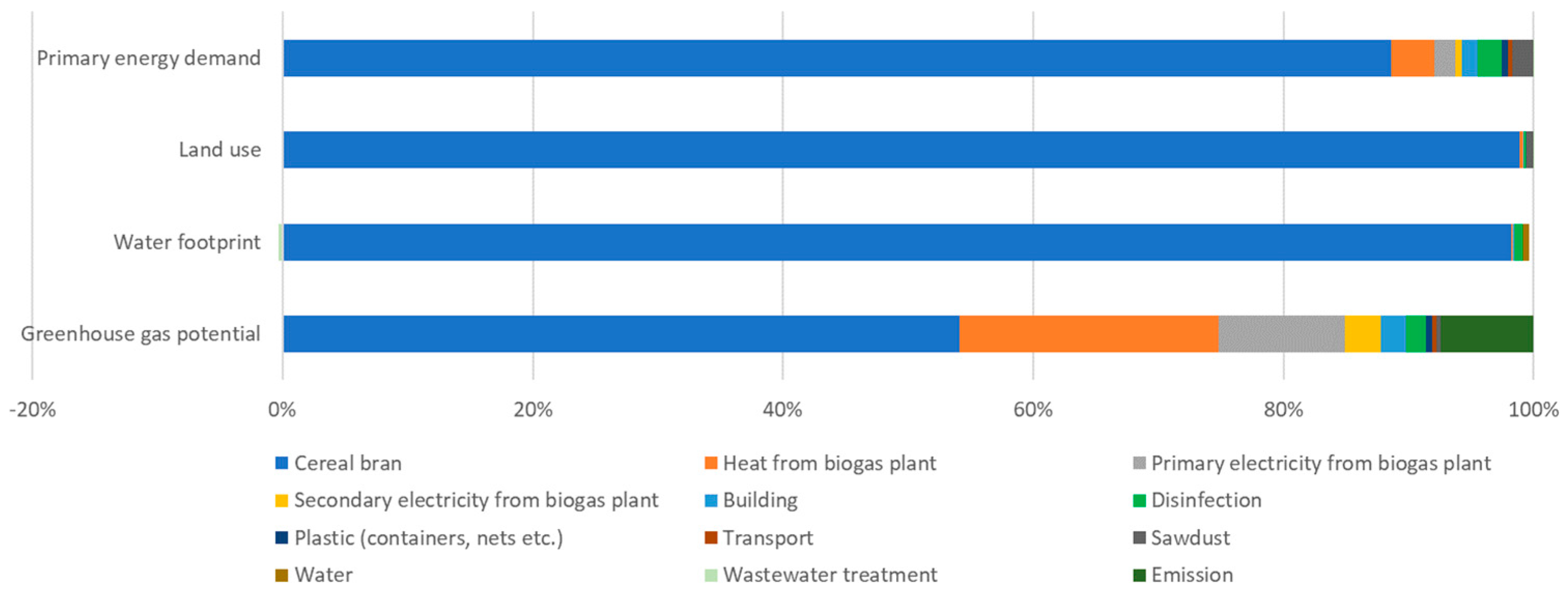



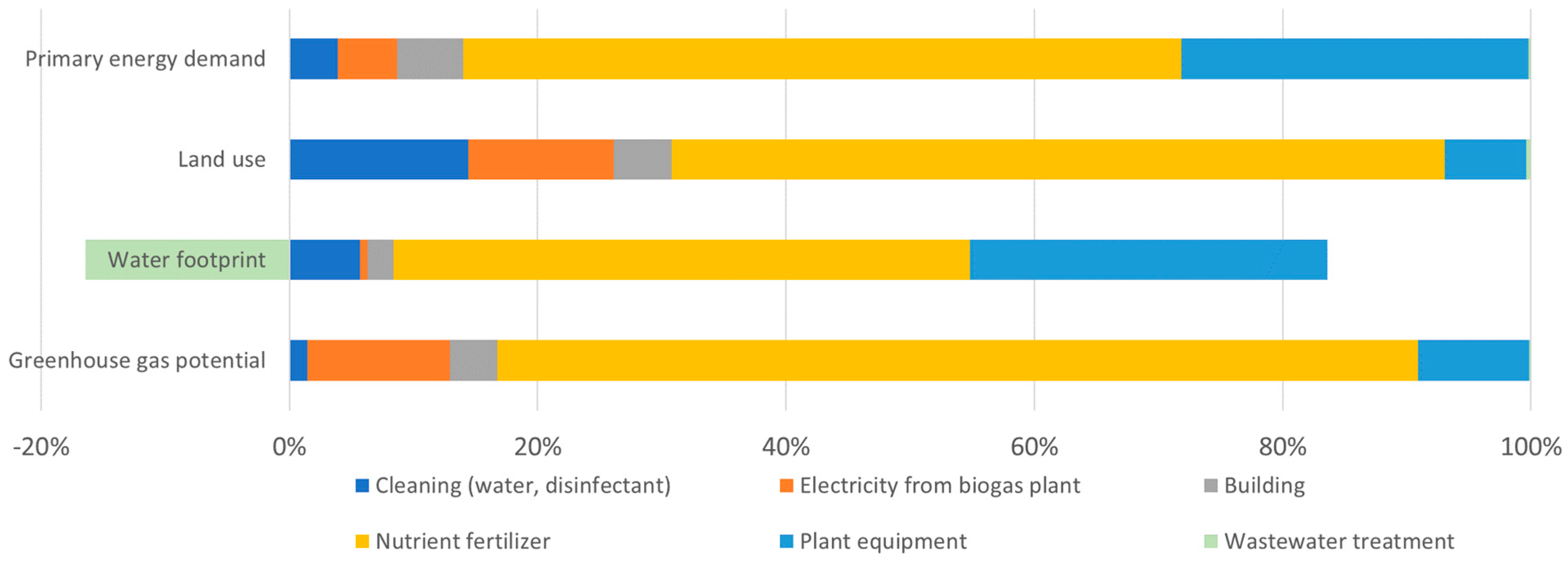
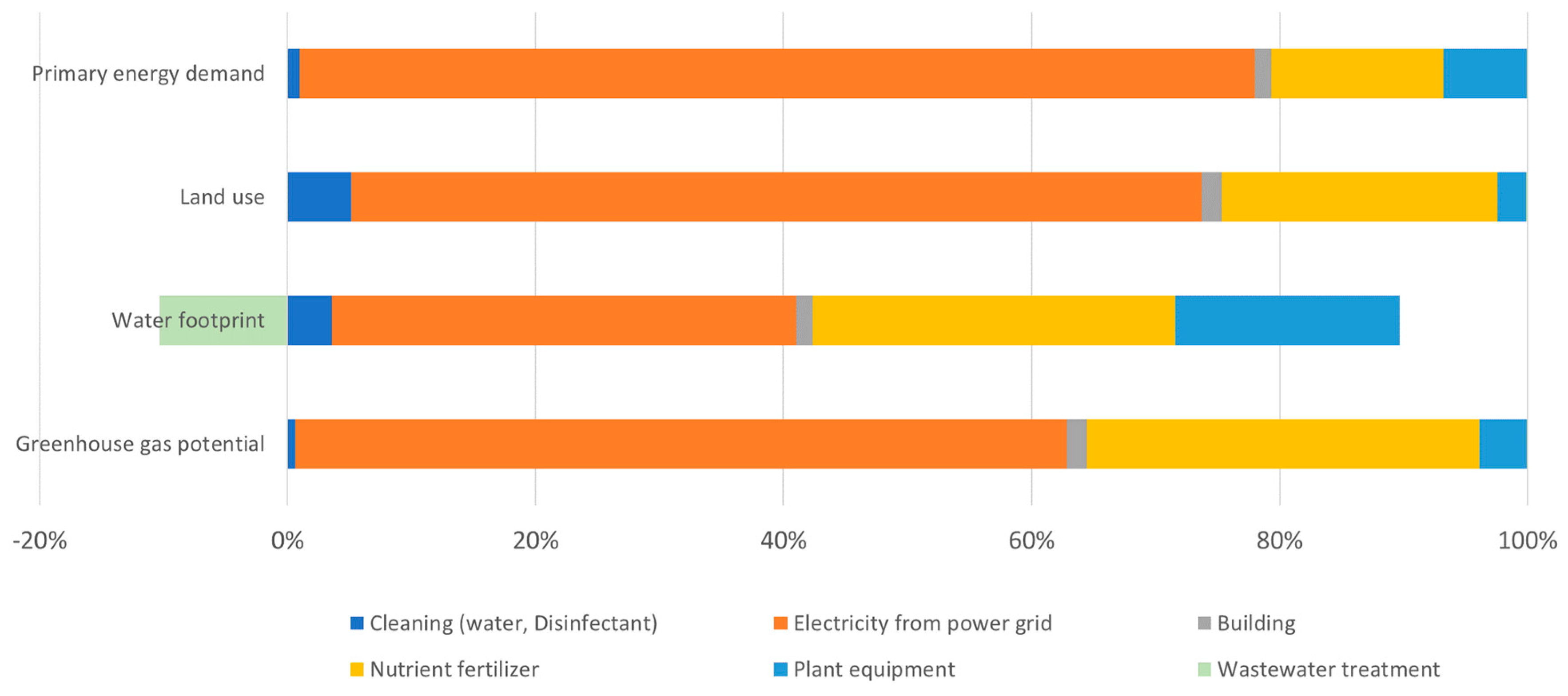
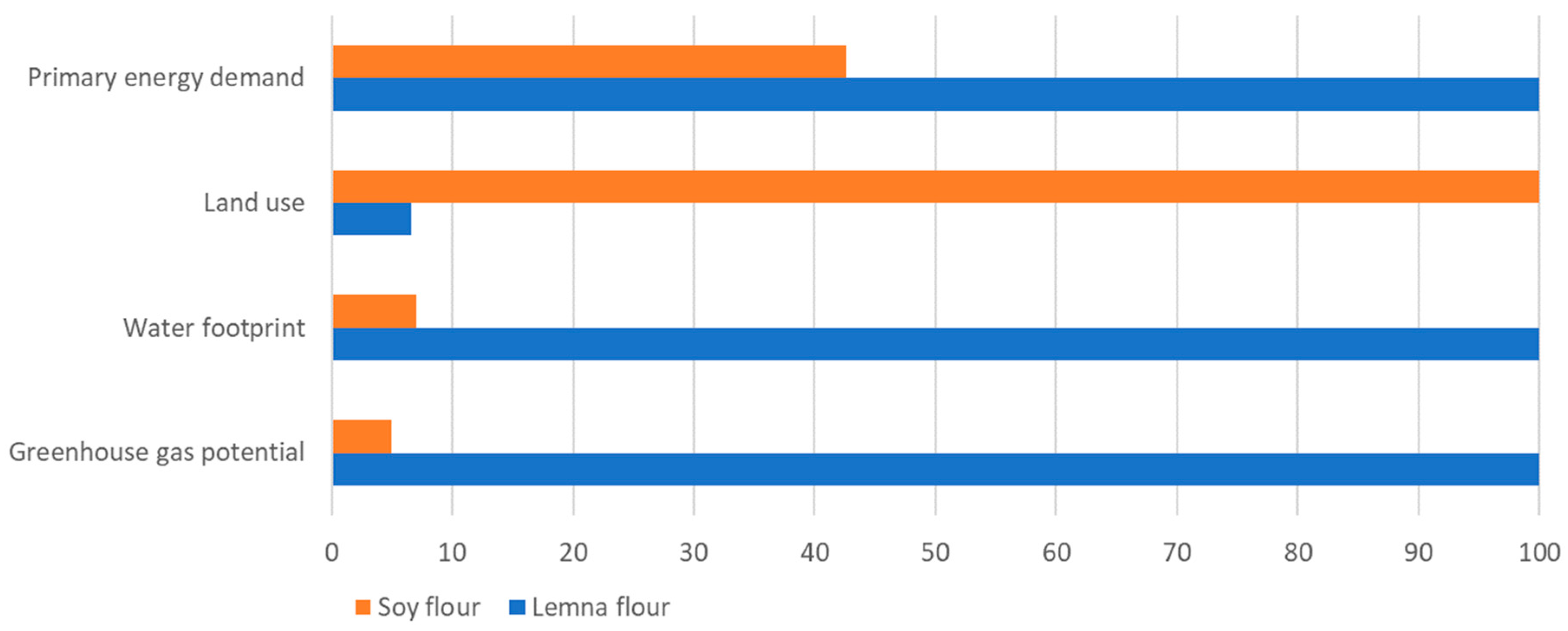

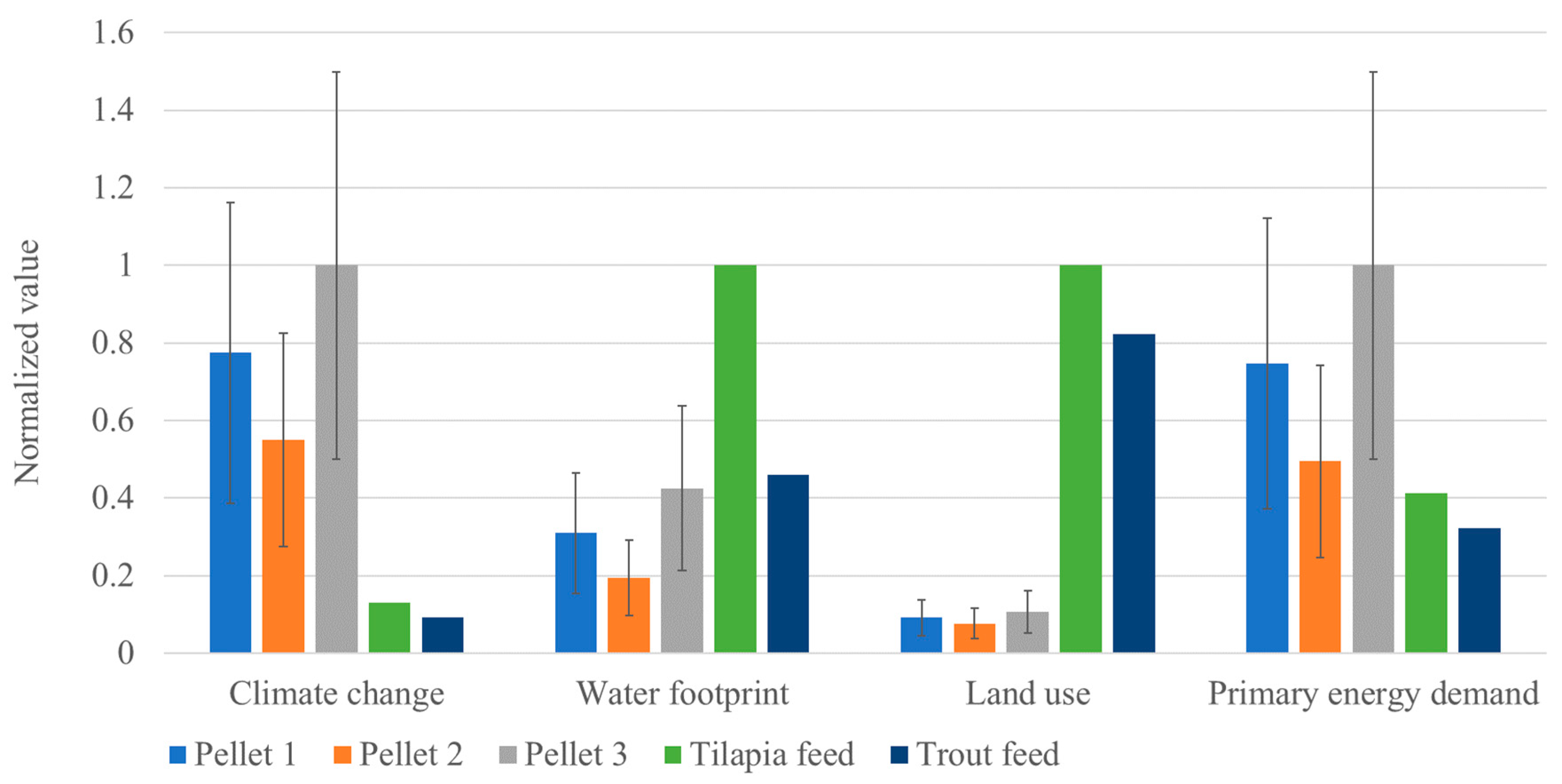


| Pellet Scenario | Percent LM | Percent BSFL | Fish Feed Characteristic |
|---|---|---|---|
| Pellet 1 | 50 | 50 | Protein content—36% Fat content—20% |
| Pellet 2 | 30 | 70 | Protein content—38.4% Fat content—26% |
| Pellet 3 | 70 | 30 | Protein content—33.6% Fat content—14% |
Publisher’s Note: MDPI stays neutral with regard to jurisdictional claims in published maps and institutional affiliations. |
© 2021 by the authors. Licensee MDPI, Basel, Switzerland. This article is an open access article distributed under the terms and conditions of the Creative Commons Attribution (CC BY) license (https://creativecommons.org/licenses/by/4.0/).
Share and Cite
Goyal, S.; Ott, D.; Liebscher, J.; Höfling, D.; Müller, A.; Dautz, J.; Gutzeit, H.O.; Schmidt, D.; Reuss, R. Sustainability Analysis of Fish Feed Derived from Aquatic Plant and Insect. Sustainability 2021, 13, 7371. https://doi.org/10.3390/su13137371
Goyal S, Ott D, Liebscher J, Höfling D, Müller A, Dautz J, Gutzeit HO, Schmidt D, Reuss R. Sustainability Analysis of Fish Feed Derived from Aquatic Plant and Insect. Sustainability. 2021; 13(13):7371. https://doi.org/10.3390/su13137371
Chicago/Turabian StyleGoyal, Shashank, Denise Ott, Jens Liebscher, Dennis Höfling, Ariane Müller, Jens Dautz, Herwig O. Gutzeit, Dirk Schmidt, and Rosmarie Reuss. 2021. "Sustainability Analysis of Fish Feed Derived from Aquatic Plant and Insect" Sustainability 13, no. 13: 7371. https://doi.org/10.3390/su13137371
APA StyleGoyal, S., Ott, D., Liebscher, J., Höfling, D., Müller, A., Dautz, J., Gutzeit, H. O., Schmidt, D., & Reuss, R. (2021). Sustainability Analysis of Fish Feed Derived from Aquatic Plant and Insect. Sustainability, 13(13), 7371. https://doi.org/10.3390/su13137371






